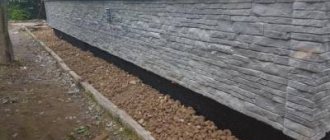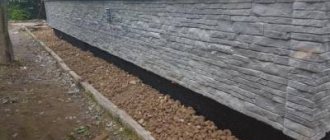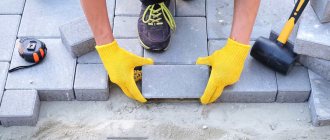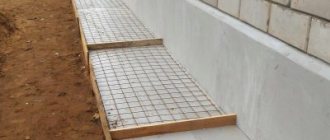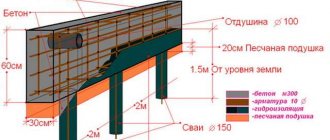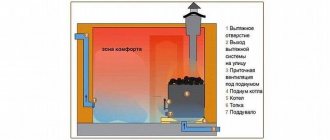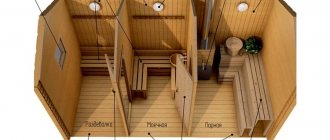Pressure from earth masses has a detrimental effect on the foundation, cracks appear, and pieces of cladding fall off. In addition, the thermal insulation of the room suffers.
The first floor of the house becomes cold, the floors freeze, and dampness forms in the underground. Heating a building requires more resources, and heating costs are rising.
According to research, the presence of an insulated blind area increases the temperature inside the building, allows you to preserve its integrity for a long time and significantly saves the heating budget. Most often, the blind area is insulated if the house has a shallow foundation or there is a basement floor.
We will tell you in the article how to make an insulated blind area around the house with your own hands.
When can you insulate yourself, and when should you turn to professionals?
The blind area is one of the simplest elements in the construction of a private house. Any homeowner who knows how to work with their hands can handle it themselves. The main thing is to follow the technology of the device and correctly create a “layer cake” from building materials inside the structure.
There are 3 types of blind area:
Tough. It is based on pouring concrete or paving. The participation of specialists is recommended here, since the technology is labor-intensive and will require hiring equipment and auxiliary tools.- Semi-rigid. The final covering here is made of paving slabs, which lie on a concrete base.
Laying out the material and pouring the base require certain skills; it is not always possible to carry out the process efficiently the first time on your own. - Soft blind area. The technology does not involve concrete, so this process is easier to do yourself.
Accordingly, you can insulate the blind area with your own hands with a soft coating that does not require the participation of equipment and concrete work. For other types of coating, the intervention of professionals may be required, but if you act carefully and according to the instructions, insulation and installation of the coating yourself is possible for everyone.
Use of extruded polystyrene foam
If a private house has a warm basement or basement, the blind area can be insulated with extruded polystyrene foam. Thus, you will insulate the foundation walls and with your own hands will ensure a warm and dry atmosphere in the basement.
Expanded polystyrene is produced in slabs of various sizes and thicknesses, has low thermal conductivity, is resistant to mold, does not rot, and in the absence of mechanical damage can last up to 40 years.
Insulating a blind area with foam plastic has one drawback - the presence of seams between the slabs. Moisture can seep through these seams, and if the insulation gets wet, it will not be able to fully perform its functions.
Requirements for insulation
There are a great variety of thermal insulation materials on the market today. The best options for insulating a blind area should have the following properties:
- Coefficient of thermal conductivity . The operating conditions in a particular region matter. The lower this indicator, the better the insulation performs its main function.
- Humidity and biostability . The material must be dry, the amount of moisture inside is minimal, since otherwise it will affect the integrity of the blind area itself. Its physical properties should not change due to temperature changes. The presence of moisture in the pores directly affects the proliferation of microorganisms.
- Ability to absorb water . The less water the insulation absorbs, the lower its thermal conductivity. High-quality material for the blind area should not be susceptible to moisture, the indicator is indicated as a percentage. When choosing between the same insulation from different manufacturers, the water absorption indicator should be decisive. It is recommended to choose the one with the lower percentage.
- Density. For the blind area, you should choose materials with high density, since it will be in conditions of high humidity and under the influence of atmospheric conditions. The marking is displayed in kg/m3, the maximum value is 400.
- Strength. Affects susceptibility to mechanical stress. Soil heaving should not affect the physical properties of the insulation. For the blind area, insulation with a strength above 5 MPa is chosen. This also affects integrity during transportation.
- Durability and frost resistance . For blind area insulation, these are the two most important indicators that directly affect the safety of the building’s foundation and the structure itself. The indicators show what temperature the insulation can withstand and how long it will last under operating conditions.
For the blind area, solid types of insulation are used, elastic and frost-resistant. Also, they should not shrink, as this could cause the entire structure to deform.
Do you need a vertical thermal protection belt?
Proper insulation of the blind area is not limited to placing thermal insulation under the concrete covering; the thermal protection must be combined with the vertical insulation belt of the foundation. This is necessary in order to prevent heat leakage through the concrete itself, which has high thermal conductivity.
Therefore, parallel to the installation of insulation of the blind area, polystyrene foam slabs are fixed to the above-ground part of the foundation with glue and disc-shaped dowels, which are subsequently hidden under the finishing of the base. It is extremely important that the thermal protection of the foundation and blind area has a continuous contour. The best option is when a horizontal belt is first laid, and then the base thermal insulation slabs rest on it with their lower end.
Which material to choose?
Since the material is subject to rather stringent requirements, only a few are suitable for insulating blind areas. Each of them can be installed independently.
Expanded polystyrene
A type of foam plastic, it is used more often than other materials due to its versatility and low cost.
Advantages:
- low thermal conductivity and moisture absorption;
- high strength;
- frost-resistant;
- flexible;
- service life reaches 80 years.
Disadvantages: flammable, it is important to securely lock it under the top layer of the blind area and cover it with the plinth facing material.
Suitable for all types of blind areas, ideal for concrete coverings , but it is necessary to lay it with additional insulating material (film or geotextile) to eliminate mechanical impact and the possibility of fire.
Penoizol
It is sprayed on the base of the building and on the bottom of the trench, under the blind area, where a cushion of clay, sand and geotextile is laid.
Advantages:
- applied without joints, in a uniform layer from a special machine with a sprayer;
- dense, does not absorb moisture;
- low thermal conductivity;
- does not allow oxygen to pass through.
- durable, non-flammable.
Flaws:
- application requires the participation of specialists with equipment;
- toxic, respiratory protection is required for all those present and isolation of the neighboring area (so that the plants are not damaged).
Penoizol is not recommended for regions with high humidity and places where there is heavy rain. The material cannot withstand excess water levels and its application is expensive. Sold in various forms, including sliced.
Styrofoam
One of the most famous materials, elastic, is suitable for strengthening expansion joints.
Pros:
- low thermal conductivity;
- affordable;
- easy to lay and model to the desired shape.
Minuses:
- easy to damage mechanically (reinforced mesh is required during installation);
- subject to combustion;
- if the density is low, moisture absorption is high.
Polystyrene foam lasts much less time than other insulation materials. But it is simple to replace and easy to install yourself.
Expanded clay
The most harmless, environmentally friendly, natural material. It is created from a mixture of clay and slate.
Advantages:
- to use, you don’t need anything other than a shovel - it’s simply poured into a trench;
- non-toxic;
- It's inexpensive.
Disadvantages: not recommended for hard blind areas. Lightweight material is intended for insulation of structures covered with crushed stone, gravel, and lawn.
Several finishing options
After laying on the slope-forming layer, the profiled membrane is covered along the edge with a layer of crushed stone, on which a curb stone is placed on a cement/concrete lock. This option has an important advantage - ease of execution, in addition, the membrane removes moisture under the curb stone. But there is also a minus: it is inconvenient to walk on the crushed stone surface, and the crushed stone itself quickly spreads throughout the entire area.
The construction of pedestrian paths is a little more complicated. The profiled membrane must be covered with a layer of crushed stone, separated by a layer of thermally bonded geotextile, and sand laid on top. In this case, it is important to choose thermally bonded geotextiles rather than needle-punched geotextiles, since the latter does not allow water to pass through well and if it is installed, water will absolutely not be able to quickly escape from the structure. Blind areas and sidewalk paths with a profiled membrane are laid on the underlying layer without the use of cement materials, for example, dry mix. Paving slabs are installed on the prepared base. This blind area looks beautiful, and it is also repairable.
The so-called “green” blind area is gaining popularity, in which the finishing layer looks like an ordinary lawn. In this case, after the profiled membrane with a layer of geotextile, a layer of crushed stone is laid, and fertile soil is poured on top of it. In the spring, the area of the blind area is sown with lawn grass. In this design, it is advisable to install rain trays in areas of greatest accumulation of water to collect moisture. Otherwise, clearings in the lawn may form in these places.
Regardless of the choice of finishing coating, an insulated blind area is a kind of guarantee of the durability of the foundation, and, consequently, the entire house. Performing several functions simultaneously - protection against freezing and frost heaving, increasing energy efficiency, draining water - it extends the life of the structure and relieves home owners from the headaches associated with premature repairs.
How to calculate the required amount of building materials?
If polystyrene foam is used as insulation, it is laid in several layers, since the standard thickness of 5 cm is not enough to maintain the temperature in the ground.
For central Russia, 2 layers are enough, that is, 10 cm thick. For northern regions 3 layers. The quantity is calculated by square meters, taking into account overlaps on the wall of the building.
Example : the perimeter of a building is 8*4 meters = (8+4)*2 = 24 m. With a standard blind area width of 1 m, it turns out that only this part requires 24 m2 of polystyrene foam. The overlap on the wall is equal to the same perimeter, but its height is 30 cm.
We count 24*0.3 = 7.2. With a reserve of 8 m2. A total of 32 m2 of polystyrene foam is needed for laying in 1 layer. For a double bottom layer you need 24+24 = 48 m2. And 8 m2 for the walls. A total of 56 m2 of polystyrene foam will be required.
For foam plastic, the calculation follows the same scheme , but depends on the thickness of the material.
If the tiles are initially larger than 10 cm, then the insulation is placed in one layer. This means, if you look at the example above, 32 m2 including the walls. Penoizol is calculated based on consumption per 1 m2. The layer thickness should not be more than 25 cm; at standard air temperatures and normal winter (not northern or southern regions), up to 15 cm is sufficient. According to manufacturers’ calculations, 1.3 liters per 1 m2 is required.
Example : similar to the previous calculation. The blind area itself requires 24 * 1 * 1.3 = 32 liters of mixture. On the wall 24*0.3*1.3 = 10 l. Total 32 l. Here it is also recommended to take with a reserve of 35 liters. Expanded clay is sold in cubic meters, consumption is calculated based on the height of the layer.
Example: a layer of expanded clay is 10 cm, the building parameters are still the same. 0.01 m3 is consumed per 1 m2. We calculate 10*24 (area of the blind area)*0.01 = 2.4*1000 = 2400 liters. Total: according to the given parameters, you will need 2400 liters of expanded clay. It is packaged in 50 liter bags. Divide 2400 by 50. This means you need 48 bags of expanded clay.
To each calculation you need to add a few more units in case of errors or omissions. If the building has a porch, near which there is no blind area, then its length must be subtracted from the perimeter.
Drainage installation for a blind area around the house
The need for drainage arises in the following cases:
- if the soil is clay or loam;
- if the soil is dusty with a high degree of humidity;
- if the building is located in a lowland;
- if there is a risk of seasonal flooding;
- if groundwater is located close to the surface of the earth;
- if centralized sewer or water supply lines are located nearby.
Stages of work performed:
drains should be prepared, which are often used as ordinary plastic pipes with a diameter of 11 cm, intended for the installation of sewer systems. Do-it-yourself holes in the plastic are drilled with a thickness of at least 1 mm with a gap between them of 2-2.5 mm; A ditch with a depth of 80 cm to 1 m is dug along the base of the house. The guideline for the correct one is the following: the depth of the pipes should be 40-50 cm below the level of the basement of the house;
the bottom of the ditch is leveled taking into account the slope, which should be oriented towards the nearest well. These can be located in each corner of the building or removed from it at a distance not exceeding 20 m; the slope of the pipes should be 0.7-1° for each linear m of pipeline towards the inspection well. If the length of the trench to the well is more than 25 m, then the difference between the highest and lowest points of the pipes laid on the bottom should not exceed 20 cm; drains should be wrapped with your own hands in a special “breathable” fabric: geotextile
This will prevent soil from getting into the holes; crushed stone 15-20 cm thick is poured onto the leveled and compacted bottom of the trench, which is carefully compacted; drains wrapped in geotextile are laid; When filling drains with soil, special attention should be paid to compacting it along the sides and at the foundation; then the first one is arranged around the house: the underlayment.
What is required to create a warm structure?
To build a blind area outside the house you will need:
- shovels, shovels and bayonets;
- gloves;
- vibrator;
- plumb line, tape measure, thread, pegs;
- sharp knife;
- boards for formwork;
- rule.
Materials:
- sand;
- crushed stone;
- clay;
- waterproofing;
- thermal insulation;
- geotextiles;
- covering: concrete, paving slabs, granite chips, lawn, etc.
Depending on the type of blind area, some of the listed materials and tools may not be needed.
Correct insulation technology
The first steps in the process of building a blind area are the same:
Dig a ditch with a depth of ½ the depth of soil freezing (approximately 30-40 cm). The width is 20 cm greater than the width of the roof overhang. Treat the bottom with chemicals that prevent plant growth and the appearance of insects.- Form the bottom at an angle from the building of about 10 degrees. Dig a groove along the outer edge of the trench for the drainage pipe.
- Pour moistened clay or sand up to 10 cm high into the bottom. Compact with a vibrating machine.
- Place waterproofing with an overlap of up to 20 cm on the wall.
- Pour 10 cm of crushed stone on top as drainage.
- Compact another 10 cm of wet sand.
Next, a layer of thermal insulation is laid . Each uses its own technology:
- Expanded polystyrene is laid in slabs.
- Penoizol is applied with a sprayer (special machine) evenly over the entire area of the blind area with a small backdrop on the wall. It does not form seams and creates another additional layer of waterproofing.
- The foam is laid in tiles evenly. If necessary, the material is cut and formed into the required area.
- Dronite is poured before and after expanded clay. The expanded clay itself is 10 cm thick.
There should be 2-3 cm of free space between the blind area and the wall of the building; it is called an expansion joint. It is left in case of shrinkage of the building and seasonal expansion of natural building materials (wood).
After this, the process is completed with a finishing coating:
- Pouring concrete. A blind area is installed around the entire perimeter. A reinforced grid is laid on the heat-insulating layer. Next, damper joints are installed along the entire perimeter in increments of 2 meters - boards 2.5 m thick. Concrete is poured in one layer at an angle of up to 10 degrees from the house. Ironing is carried out, complete drying with periodic moistening.
- Paving slabs are made according to the same principle, only the layer of concrete is 2 times thinner and tiles are laid on top.
- The soft blind area is laid out without reinforcement or concrete. A layer of sand and gravel is poured onto the insulation and covered with geotextiles. And the final layer is placed on this coating: gravel, granite chips, drainage with lawn and others.
A layer of thermal insulation is also laid on the lower part of the wall, its height is up to 30 cm. It lies inside the expansion joint and serves as a softening elastic stop. At the final stage of construction, the insulation layer is covered with the finishing of the base.
The video will tell you about insulating the blind area with polystyrene foam:
Briefly about the next steps
After this, it is necessary to start implementing drainage located along all edges of the installed blind area. This can be done in several different ways.
First option. Asbestos-cement pipes, the diameter of which should reach 100 mm, are laid close to the blind area on an underlying layer of crushed stone or sand. They must first be cut in half.
Second option. A special monolithic concrete trench is installed over the crushed stone bed. To ensure the most suitable shape, you can use a small piece of metal pipe or a pre-sanded log.
Drainage arrangement
It is very important to properly insulate the blind area, because the preservation of heat in the house, its stability and service life directly depend on it.
What mistakes can there be and how to avoid them?
Main mistakes:
- laying polystyrene foam in one layer - there is no need to save money, the more reliable the thermal insulation, the more durable the entire structure will be;
- the overlap on the wall is done for greater thermal insulation efficiency and protection of the foundation from freezing - you should not forget about it;
- The lamellar insulation is laid in even layers, the seams are connected as tightly as possible - if you put the material overlapping, cracks will form.
Insulation is recommended for all types of blind areas in Russia, since most regions experience severe winters.
The absence of this detail is detrimental to the foundation of the building; the cold quickly destroys it, making the house uninhabitable. If errors occur with the installation of insulation, the blind area is completely disassembled and the procedure is repeated correctly.
What is an insulated blind area and what does it consist of?
This is a strip with a width of at least 60 cm, but with the condition that it cannot be smaller or coincide with the overhang of the roof, made of different building materials with the mandatory use of insulation, located along the perimeter of the building and designed to protect it from moisture and low temperatures. Regardless of what it is decided to build protection for the foundation from, two types of mandatory work will need to be performed:
- make the first layer: underlying;
- make the top layer: coating (facing).
This will prevent the occurrence of mold and mildew and premature aging of the building materials from which the foundation and base are made. The issue of the occurrence of cracks due to seasonal soil movements is also resolved.
Expenses
Average prices for insulation in Russia:
Expanded polystyrene. The price depends on the thickness and volume of purchase. Piece by piece 2 cm - from 55 rubles/piece, 5 cm - from 115 rubles/piece, 10 cm - from 250 rubles/piece. The standard plate size is 118.5*58.5.- Styrofoam. 1 cubic meter from 220 rubles.
- Penoizol. The work is carried out by specialists from 140 rubles/cubic meter. They bring the mixture ready for application and spray it, creating a thermal insulation layer.
- Expanded clay. Bag 50 l from 120 rub.
You will find a lot of important and useful information about insulating the blind area around the house in this section.
Mistake #3. Violation of regulations for concrete work
This often happens if they are measured by eye. Experts strongly recommend abandoning such frivolity. Making concrete is not a case where you can count on chance. You can accurately dose the components even in country conditions. How? In my opinion, nothing better than ordinary buckets has yet been invented, and if in addition you use a steelyard (even a very simple one), the weighing accuracy will be sufficient. Cracks in the blind area are the result of an incorrectly prepared concrete mixture
Concrete mix proportions
Traditionally, the proportions of the mixture are calculated based on 1 m³ of the finished batch. As an example, I propose to calculate the proportions for concrete M 250 (the most popular brand of mixture for low-rise construction). For getting
1 m³
M 250 solution will be needed:
cement grade M 400 – 332 kg;
- crushed stone – 1080 kg;
- sand – 750 kg;
Mixing time
How long does it take to rotate the bulb of a household concrete mixer? To mix the dry ingredients, 2 minutes are enough, and after gradually adding water, another 2 minutes. Not only the sequence of adding components is important, but also the mixing time
Compaction and tilt
The final stage of concreting is compacting the concrete mixture and imparting a slope in the transverse direction. You will have to rent a vibrating plate, the operation of which will ensure high quality finishing work.
To eliminate small gaps from temperature effects, it is enough to use sealants and fillers. The wide hole is filled with sand and cement with fine crushed stone to ensure optimal insulation.
The dry coating is treated with a primer. The same actions are performed with cracks in the surface of sections.
The presence of a concrete strip around the perimeter of the house is a guarantee of the reliability and durability of the foundation of the house
But in order for the structure to be as durable and functional as possible, it is important to follow the rules of its construction and follow the instructions exactly. It is also important to correctly calculate the thickness of the concrete blind area, apply all the required markings and be careful at each stage of construction
We suggest you read: How to make a hamam dome

